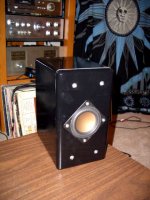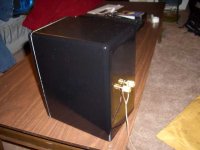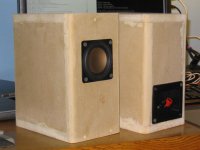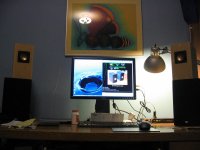Well, since its a line input on a minisystem, its probably opamp buffered. That means, in my experience, at least 1 megaohm input impedence.
If you calculate R2 given a 1 megaohm input impedence, then you get 52k instead of 50k. If you'd like to use a 52k ohm resistor, that might be a bit closer. But needless to say, at those high of input impedances, it doesn't affect the R2 value by much at all. It would get hairy if you had a non-input buffered amp, like a simple solid state, or tube amp or something, that had a lower input impedance. You might try recalculating for something like 47k input impedance, just as an educational experience.
The FMOD probably assumes a really high input impedance, like we are. If it was used with a low input impedance amp, it wouldn't work right either.
As to quality of components, having nice components will help, but mostly because of high precision. I'd recommend getting 1/4 watt Vishay Dale metal film resistors (or the metal film resistors of your choice, just make sure they are 1% precision), and polyester capacitors, in 5% precision, if possible. Remember that you don't need much voltage rating, so you can use cheaper (and smaller) components, 10 or 16V is probably the smallest you'll find, and they'll work fine.
peace,
sam
If you calculate R2 given a 1 megaohm input impedence, then you get 52k instead of 50k. If you'd like to use a 52k ohm resistor, that might be a bit closer. But needless to say, at those high of input impedances, it doesn't affect the R2 value by much at all. It would get hairy if you had a non-input buffered amp, like a simple solid state, or tube amp or something, that had a lower input impedance. You might try recalculating for something like 47k input impedance, just as an educational experience.
The FMOD probably assumes a really high input impedance, like we are. If it was used with a low input impedance amp, it wouldn't work right either.
As to quality of components, having nice components will help, but mostly because of high precision. I'd recommend getting 1/4 watt Vishay Dale metal film resistors (or the metal film resistors of your choice, just make sure they are 1% precision), and polyester capacitors, in 5% precision, if possible. Remember that you don't need much voltage rating, so you can use cheaper (and smaller) components, 10 or 16V is probably the smallest you'll find, and they'll work fine.
peace,
sam
P.S. My zaph B3S speakers are coming along nicely too.  I just finished rounding over all the edges, and doing the final finishing sanding. They are currently sitting in the basement with a layer of high-build primer awaiting a glossy black paint job. The test unit I set up last night sounded great, I'm looking forward to having them in action.
I just finished rounding over all the edges, and doing the final finishing sanding. They are currently sitting in the basement with a layer of high-build primer awaiting a glossy black paint job. The test unit I set up last night sounded great, I'm looking forward to having them in action.
peace,
sam
peace,
sam
just so you know sam, your posts are very much appreciated...im gonna figure out exactly where i want em crossed over, work the calculations, and buy the parts tomorow, so if i run into any other issues i will post here this weekend, so if you dont mind checking in sometine this weekend, that'd be sweet 
PS. GL with ur project, these things sound sweet
PS. GL with ur project, these things sound sweet
well after many listening tests conducted while adjusting this computerized crossover, i figured out that i probably wont be crossing over @ 200 Hz anymore, cuz i gotta get up to around 275 to get the sound at its best...im just not sure how much this is going to resemble the passive in line crossover, should i build it for 275? zaphs page says to set the reciever to 150Hz, but that along with the plate amps 150 Hz crossover results in a much higher order crossover than i will have with my passive in line...so should i build it higher or lower?
also, i was checking madisound looking for some 50k ohm metal film resistors, and i couldnt find any higher than 50 ohm...guess i gotta find some other e-stores
also, i was checking madisound looking for some 50k ohm metal film resistors, and i couldnt find any higher than 50 ohm...guess i gotta find some other e-stores
ok here is what i have found thus far:
71-CCF55-100K CCF55100KFKR36 Vishay/Dale 1/4WATT Metal Film Resistors
1/4watt 100Kohms 1% Rated to 1/2WATT
4 Ships Now
$ 0.050 $ 0.20
71-CCF55-10.5K CCF5510K5FKR36 Vishay/Dale 1/4WATT Metal Film Resistors
1/4watt 10.5Kohms 1% Rated to 1/2WATT
4 Ships Now
$ 0.050 $ 0.20
505-MKS2.1/63/5 MKS2-.1/63/5 Wima Polyester Film Capacitors
63V .1uF 5% - RoHS COMPLIANT per producer documentation
2 Ships Now
$ 0.250 $ 0.50
505-MKS02.01/63/5 MKS02-.01/63/5 Wima Polyester Film Capacitors
63V .01uF 5% - RoHS/Pb-FREE per producer documentation
2 Ships Now
$ 0.550 $ 1.10
i am ordering 4 100Kohm 1% 1/4 watt metal film resistors since i cant find any 50Kohm ones on this site...i will just hook up to in parallel to achieve the desired load....also, i couldnt find any 5K so i am ordering 4 10.5 K and will wire two each in parallel for each channel...
the caps are rated @ 63 V which is a bit higher than you mentioned but were the lowest availible on this site...i would really like to discuss what i have on the order page so i can make sure i am not making any mistakes with the purchase...i guess it is rediculously cheap so it doesnt really matter tho
i am curious to know, phidauex, why i am using 1/4 watt resistors, or 1% resistors...i know i need a 50kohm metal film resistor, but how do you know the other details? i am trying to learn everything i can
71-CCF55-100K CCF55100KFKR36 Vishay/Dale 1/4WATT Metal Film Resistors
1/4watt 100Kohms 1% Rated to 1/2WATT
4 Ships Now
$ 0.050 $ 0.20
71-CCF55-10.5K CCF5510K5FKR36 Vishay/Dale 1/4WATT Metal Film Resistors
1/4watt 10.5Kohms 1% Rated to 1/2WATT
4 Ships Now
$ 0.050 $ 0.20
505-MKS2.1/63/5 MKS2-.1/63/5 Wima Polyester Film Capacitors
63V .1uF 5% - RoHS COMPLIANT per producer documentation
2 Ships Now
$ 0.250 $ 0.50
505-MKS02.01/63/5 MKS02-.01/63/5 Wima Polyester Film Capacitors
63V .01uF 5% - RoHS/Pb-FREE per producer documentation
2 Ships Now
$ 0.550 $ 1.10
i am ordering 4 100Kohm 1% 1/4 watt metal film resistors since i cant find any 50Kohm ones on this site...i will just hook up to in parallel to achieve the desired load....also, i couldnt find any 5K so i am ordering 4 10.5 K and will wire two each in parallel for each channel...
the caps are rated @ 63 V which is a bit higher than you mentioned but were the lowest availible on this site...i would really like to discuss what i have on the order page so i can make sure i am not making any mistakes with the purchase...i guess it is rediculously cheap so it doesnt really matter tho
i am curious to know, phidauex, why i am using 1/4 watt resistors, or 1% resistors...i know i need a 50kohm metal film resistor, but how do you know the other details? i am trying to learn everything i can
Using resistors in parallel to get the correct value is fine. It makes your filter bigger, but its no problem. I used 3 10kohm resistors in series to make a 30k for an attenuator the other day. 
Its usually OK to go with larger components than you need, but never ok to go smaller. So if 63V capacitors is what you are finding, then that will work fine, assuming the price is modest.
As far as resistors go, the wattage rating is how much power they can dissipate without blowing up. 1/4 watt is fine for this application, but larger ones would be OK. These line level signals are very weak, and don't involve much power, so small resistors are best.
The precision rating on electronics tells you how close the size rating is to the reality. A 100,000 ohm resistor is never exactly 100,000 ohms. "Regular" carbon film resistors are 5% precision, meaning a 100,000 ohm resistor could be as high as 105,000, or as little as 95,000 ohms. A 1% resistor will be somewhere between 101k, and 99k (usually much closer). Your ear is sensitive to small changes in component value. Its not that important what the component value is for your filters, but it IS important that they be the same for both filters. If your two channels sound a tiny bit different, you may notice it! Keeping the circuitry on your two channels as similar as possible, both in layout and component values, is a good habit to get into.
Those resistors are exactly what I had in mind, and the Wima caps should work as well.
The capacitors could be just about any of the polyester capacitors, at nearly any voltage rating. Just remember that the higher the voltage rating, the more expensive, and the larger, they will be. Try to get 5% or better tolerance. You should just peruse the brands (perhaps even download the pdf catalog so you can browse easier), and see what offers the values you need (or closest to them), and then which of those will be the smallest and cheapest.
If you are able, buy an assortment pack of metal film resistors. Unless this is your last DIY project, you'll need more with time, and those Vishay dale resistors are great standard audio resistors.
Also, buy extra of every part you buy. You'll want to develop a little 'parts box', and you'll want backups in case you accidentally toast a part. Its just a few extra cents, and its worth it to have the insurance.
Hope this helps!
peace,
sam
Its usually OK to go with larger components than you need, but never ok to go smaller. So if 63V capacitors is what you are finding, then that will work fine, assuming the price is modest.
As far as resistors go, the wattage rating is how much power they can dissipate without blowing up. 1/4 watt is fine for this application, but larger ones would be OK. These line level signals are very weak, and don't involve much power, so small resistors are best.
The precision rating on electronics tells you how close the size rating is to the reality. A 100,000 ohm resistor is never exactly 100,000 ohms. "Regular" carbon film resistors are 5% precision, meaning a 100,000 ohm resistor could be as high as 105,000, or as little as 95,000 ohms. A 1% resistor will be somewhere between 101k, and 99k (usually much closer). Your ear is sensitive to small changes in component value. Its not that important what the component value is for your filters, but it IS important that they be the same for both filters. If your two channels sound a tiny bit different, you may notice it! Keeping the circuitry on your two channels as similar as possible, both in layout and component values, is a good habit to get into.
Those resistors are exactly what I had in mind, and the Wima caps should work as well.
The capacitors could be just about any of the polyester capacitors, at nearly any voltage rating. Just remember that the higher the voltage rating, the more expensive, and the larger, they will be. Try to get 5% or better tolerance. You should just peruse the brands (perhaps even download the pdf catalog so you can browse easier), and see what offers the values you need (or closest to them), and then which of those will be the smallest and cheapest.
If you are able, buy an assortment pack of metal film resistors. Unless this is your last DIY project, you'll need more with time, and those Vishay dale resistors are great standard audio resistors.
Also, buy extra of every part you buy. You'll want to develop a little 'parts box', and you'll want backups in case you accidentally toast a part. Its just a few extra cents, and its worth it to have the insurance.
Hope this helps!
peace,
sam
By the way, to calculate what resistor power rating you'll need, use this guesstimation method...
Figure out what the maximum voltage that your resistors will experience. In this case, a line level signal is rarely more than 2V RMS. A powerful amplifier might be as high as 50 or 60 volts!
Then, use ohms law (volts = amps * ohms) to calculate the current that resistor will pass, in this case, a 5000 ohm resistor, with 2 volts, will pass .0004 amps. Then calculate the power, (watts = amps * volts), in this case, .0008 watts. Since a 1/4 watt resistor can handle .25 watts, you are way under its capacity. There are smaller resistors out there, but they are tricky to solder, since they are usually surface mount components. I rarely go under 1/4 watt, just because of versatility and ease of soldering.
peace,
sam
Figure out what the maximum voltage that your resistors will experience. In this case, a line level signal is rarely more than 2V RMS. A powerful amplifier might be as high as 50 or 60 volts!
Then, use ohms law (volts = amps * ohms) to calculate the current that resistor will pass, in this case, a 5000 ohm resistor, with 2 volts, will pass .0004 amps. Then calculate the power, (watts = amps * volts), in this case, .0008 watts. Since a 1/4 watt resistor can handle .25 watts, you are way under its capacity. There are smaller resistors out there, but they are tricky to solder, since they are usually surface mount components. I rarely go under 1/4 watt, just because of versatility and ease of soldering.
peace,
sam
exactly what i needed to know 
thanks again sam...gonna place the orders and build this thing, and ill post pictures of it so you can tell me how ugly it is...
what is the best way to insulate it? just wrap it in electrical tape? or should i mount it on some cardboard and put it somewhere safe...for my application it would be simpler to just air point solder it and wrap it but i do wanna do it right
but i do wanna do it right
thanks again sam...gonna place the orders and build this thing, and ill post pictures of it so you can tell me how ugly it is...
what is the best way to insulate it? just wrap it in electrical tape? or should i mount it on some cardboard and put it somewhere safe...for my application it would be simpler to just air point solder it and wrap it
I'd build up the filter on a little piece of perf board, keeping it as small as possible, and then just bundle it up with tape. If you want it to look a little nicer, get a small project box from radio shack, drill four small holes into it, chop an interconnect in half, and run the four parts into the box. Build the two filters into the box, wire them to the left and right channels. Then you have a box with an L and R in, and L and R out. Label it as a 275hz 2nd order high pass filter, and plug it in!
Speaking of ugly, here are a few pictures of my nearly finished Zaph B3Ss. They need a flatter squishing sealing tape around the baffle, but other than that, they are done! The gloss black paint is 8 coats of appliance epoxy paint. It turned out worse than I hoped, and better than I expected.
Screws are all shiny stainless steel, looks good against the black, I think.
peace,
sam
Speaking of ugly, here are a few pictures of my nearly finished Zaph B3Ss. They need a flatter squishing sealing tape around the baffle, but other than that, they are done! The gloss black paint is 8 coats of appliance epoxy paint. It turned out worse than I hoped, and better than I expected.
Screws are all shiny stainless steel, looks good against the black, I think.
peace,
sam
Attachments
The back of the speaker. The binding posts are generic posts that I ripped out of a terminal cup (drilling the hole for the terminal cup would have meant drilling out nearly the entire rear baffle!).
Every edge has a 1/2" roundover, looks pretty good!
peace,
sam
Every edge has a 1/2" roundover, looks pretty good!
peace,
sam
Attachments
phidauex said:It turned out worse than I hoped, and better than I expected.
peace,
sam
haha...thats priceless...im gonna use that line
mine still havent been stained yet...i think they look supercool as is, but i should probably stain/finish it...i just dont really know anything about that, so im gonna need to do some research first...anywho, nice project...
i ordered my res/caps today...should get em in a couple of days...i ALSO just recieved my loudspeaker design cookbook...crap this thing is complicated....i gotta read it veerrrry slowly
Just remember that, when it comes to audio, no one knows everything, or has the ultimate answer. Even people who've practically defined the industry, like Linkwitz, are still learning new things.
A friend of mine is doing a complete renovation of a home, stripped to the joists kind of deal. Every time I ask him how its going, he smirks and says, "I'm just excited about how much faster it'll go the second time, once I've learned from all my mistakes."
The second go is easier than the first, and each one after that is easier still.
peace,
sam
P.S. "It turned out worse than I hoped, and better than I expected." Thats the story of my life.
A friend of mine is doing a complete renovation of a home, stripped to the joists kind of deal. Every time I ask him how its going, he smirks and says, "I'm just excited about how much faster it'll go the second time, once I've learned from all my mistakes."
The second go is easier than the first, and each one after that is easier still.
peace,
sam
P.S. "It turned out worse than I hoped, and better than I expected." Thats the story of my life.
Shame on you guys who picked the 3BS over the much prettier-looking 3BN! I used the 3BN and it looks much nicer with is roundness!
The B3N does look nicer, but they were out of stock when I made my order. They weren't expected for several weeks, so I decided to go for old square. At least I mounted them diagonally, now they look like playing cards, which is pretty nice.
peace,
sam
I just setup my pair for a first listen. These things are amazing for their price/size--nice and clean sound. Perfect for nearfield listening. This is my first set of DIY speakers (if you don't count the Dayton RSS315 sub I helped my friend build) and I'm hooked. Next up: John Marsh's Natalie P MTM. 
Haven't decided what kind of finish I'm going to do on them; probably just a simple matte black. Truckbed liner perhaps?
What kind of internal damping are you guys using?

Haven't decided what kind of finish I'm going to do on them; probably just a simple matte black. Truckbed liner perhaps?
What kind of internal damping are you guys using?
Attachments
- Status
- This old topic is closed. If you want to reopen this topic, contact a moderator using the "Report Post" button.
- Home
- Loudspeakers
- Multi-Way
- Finished Zaphaudio b3s project :)



